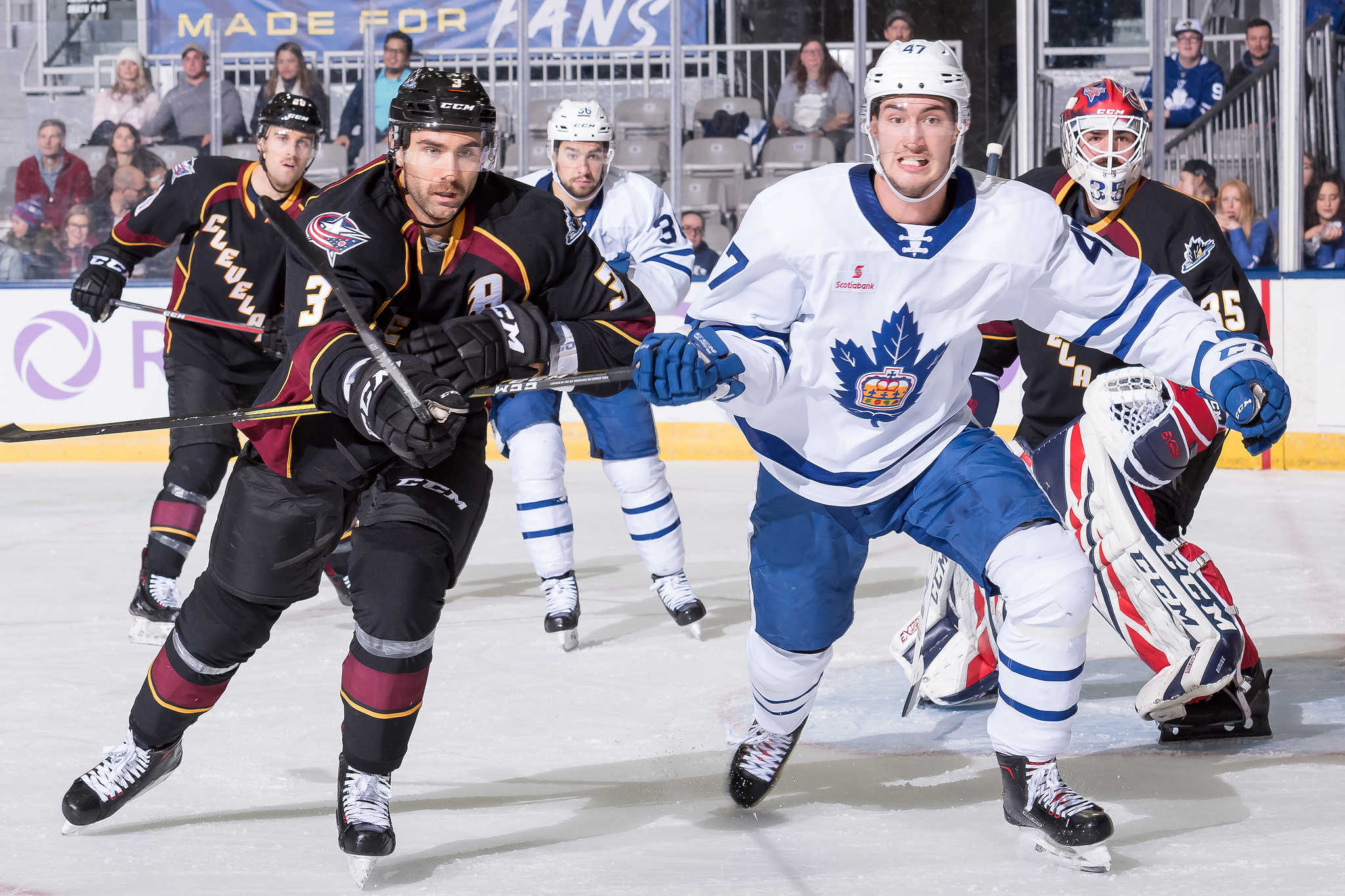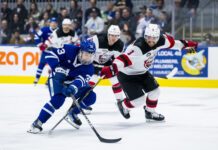Over the past two seasons, the Toronto Maple Leafs have been blessed with a tremendous top-nine forward group that has done a great deal of damage offensively, scoring at a rate of 3.43 goals per game.
This being Toronto, however, much scrutiny has been placed on the fourth line and the center position, in particular. Mike Babcock has tried out a revolving door of players in the middle of his fourth line and the organization has forked over assets via trade in an attempt to fill the spot at both the 2017 and 2018 deadlines.
Down the stretch of the 2018-19 season, after Kyle Dubas left the position unaddressed at the deadline — he actually weakened the team’s NHL center depth by flipping Par Lindholm for Nic Petan, who Mike Babcock didn’t like as a center — the 4C role remained a talking point through the playoffs and into the offseason.
With camp now opening, a plethora of depth options are auditioning to fill that gap (Jason Spezza, Nick Shore, incumbent Frederik Gauthier, potentially Nic Petan if he could prove he can play center), but could a Marlies graduate be the longer-term answer?
It’s certainly the developmental goal Kyle Dubas is striving for, with the importance of internal graduates taking over NHL roles on cheap contracts recently coming into focus again in the wake of the Mitch Marner contract and the Leafs‘ present-day cap issues. All but Nic Petan on the above list of names are signed to contracts that expire in 2020.
Enter Adam Brooks?
The Leafs‘ overage pick in the fourth round of the 2016 draft has been labeled a “slow burner” throughout his hockey career; after accumulating just 12 points a season in his first two years in the league, the Manitoba native racked up a combined 250 points in his final two WHL seasons.
You could apply the same late-bloomer tag to Brooks since he turned professional, although his quiet start in the American Hockey League was partly due to some unexpected bumps in the road: In his rookie year, Brooks battled mononucleosis before a lower-body injury and a heart scare set him back in his sophomore year.
The Marlies‘ 2018 championship run was a turning point for the 23-year-old. He centered a dominant fourth line with Mason Marchment and Trevor Moore on his wings, running roughshod over the opposition’s bottom six and playing an understated role in bringing the first ever Calder Cup to Toronto.
A 40-point haul in his sophomore season (61 games) didn’t mean Brooks grabbed too many headlines — nor did it thrust him into too many conversations as the long-term answer to the Leafs‘ fourth-line center dilemma — but that level of production was not surprising considering his aforementioned health issues during the first parts of the regular season.
The 23-year-old finished the 2018-19 campaign on an excellent run of form — 11 points in 13 games — before stepping up in the post-season. That only came after a heart-to-heart chat with head coach Sheldon Keefe following a poor performance in Game 2 of the first-round series against the Rochester Americans.
Issued a challenge by his coach to be better, Brooks took the bull by the horns. His hat-trick in Game 3 led Toronto to victory and clinched a totally unexpected round-one sweep of the Amerks. After finishing the postseason with eight points in 13 games, Brooks was tied for the team-high in goals (six) and eclipsed his production for the previous post-season in fewer games while playing a much bigger role.
Now entering the last year of his entry-level deal, it’s not quite put-up-or-shut-up time for Brooks, but he’s keenly aware of his situation and the potential to crack the Leafs roster at some point in the next year, having watched a former linemate of his in Trevor Moore successfully ascend to the big club last year.
Mike Babcock won’t be overly enamoured by Brooks’ physical attributes (5’10, 180), but he is entrusted with penalty-killing duties and is much improved in the faceoff circle after working closely with Marlies assistant coach A.J MacLean on that facet of his game (in the 4C role, we know proficiency on the dot something Babcock puts a lot of stock into).
There’s no doubt that Brooks provides a greater offensive threat and composure on the puck than Gauthier, and he still owns a similar sense of defensive responsibility that would suit a bottom-six role. Despite the lack of height and length, Brooks is competitive, has a good motor, and is willing to play in the hard areas of the ice.
In 158 regular season AHL games, Brooks has accumulated just 58 points to date, but there are encouraging signs if you look a little closer. His production is trending in the right direction and those point totals include 29 goals, 45 primary points, and 40 points at even seven strength. While he’s been used some on the power play, I wouldn’t say it’s a strength of his game and it’s not as if the Maple Leafs are likely to use him in that role anyway.
The opportunity at hand is staring Brooks squarely in the face as October fast approaches.
A top line role on the Marlies awaits him and with it comes a golden opportunity to audition as the long-term solution for the Toronto Maple Leafs’ fourth-line center role.
The rest of the Toronto Marlies’ center depth

Beyond Adam Brooks, the center depth on the Toronto Marlies has an uncertain complexion, although there are should be plenty of options. Much will depend on how the big club utilizes its summer free-agent signings including Kenny Agostino, Kalle Kossila, Tyler Gaudet, Aaron Luchuk, and Nick Shore.
I do not envision a situation that results in Shore hitting waivers this Fall — certainly not right away — and my gut feeling at this relatively early stage is that Agostino is the most credible of the remaining group to stay up with the Leafs and provide forward depth in a lineup that’s without Zach Hyman for at least the first month.
My expectation is that Luchuk will fill a bottom-six role for the Marlies, while either or both of Kossila and Gaudet could be utilized on the wing depending on the makeup of the roster coached by Sheldon Keefe.
Also up in the air: Will the experiment of playing Pierre Engvall at center continue this upcoming season? I don’t pretend to have the definitive answer to the question, and I’m far from convinced that the Swedish forward can play center at the NHL level one day, but the odds are that Toronto will extend the experiment of playing him down the middle based on how the head coach liked Engvall’s initial adaptation to the role.
After that comes a whole pile of low-end prospects on AHL deals, with the majority bound for Newfoundland. Not all of the following play down the middle as their primary position, but almost certain to end up on the rock are Riley Woods, Ryan Moore, Matt Bradley, and Marcus Power.
Colt Conrad, Hudson Elynuik, Giorgio Estephan, Zach O’Brien, Brady Ferguson, and Tanner MacMaster head up the remainder, with the first two — both of which showed well at the rookie tournament in Michigan — holding the better credentials at this stage to earn a spot at center on the Marlies to start the year.


































